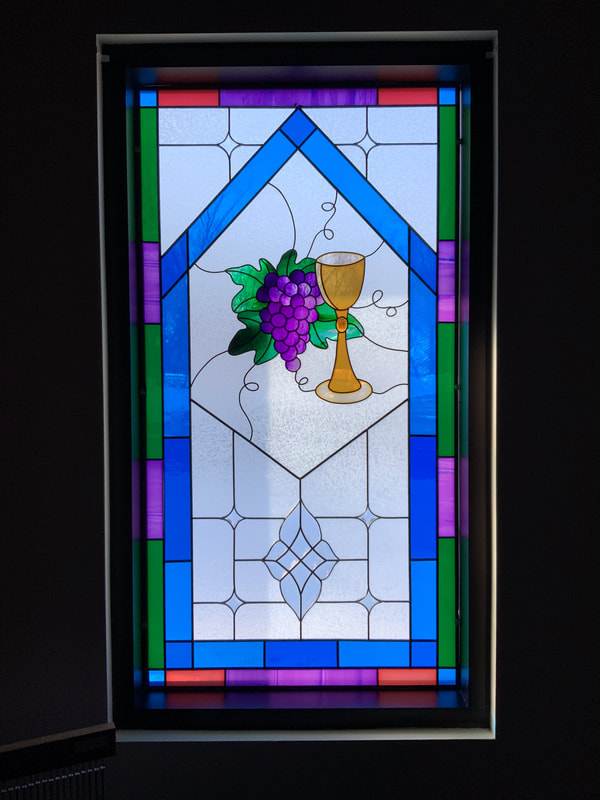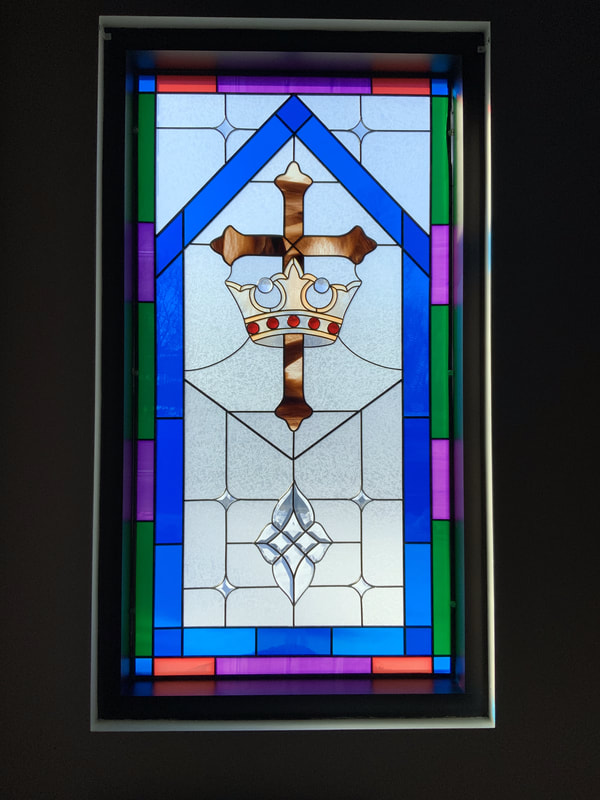THE SYMBOLS IN OUR STAINED GLASS WINDOWS
The colors of each window border proclaim the fullness of God’s love throughout the year in the various Liturgical Seasons: Blue and Purple symbolize the beginning of the church year in Advent celebrated the 4 Sundays before Christmas.
The frosted areas of each window admit the brightness and white light of the sunshine, symbolizing the white or purity of Christ’s birth at Christmas and the First Sunday of Epiphany – the season celebrating God’s incarnation in Jesus Christ. White also symbolizes the cleansing power of God’s Spirit that is open to all of us who in faith confess our sins and find forgiveness, new life and stronger faith in Holy Communion.
Green is the color of Epiphany - the season of Christ coming among us bringing new life, faith, and the holy example of life lived in harmony with God.
Purple is the color symbolizing Lent - the forty day season prior to Easter when we reflect on Christ’s suffering and death on the cross and its meaning for all of us.
Red is the color for Pentecost – symbolizing the coming of the Holy Spirit to the church on Pentecost Sunday as revealed in chapter two of the Book of Acts.
The stars in each window remind us of the Star of Bethlehem, the birth star of our Savior Jesus Christ. As the angels revealed God’ glory to the shepherds in the field and as the Wise Men traveled from the East, the star led them to Bethlehem where Christ was born.
The pointed blue border and peak in each window remind us of our tower and entrance to this sanctuary that has been integrated into the design of our pulpit and communion table. This shape suggests the familiar outline of a church steeple, the symbol of sanctuary and hope for the world.
The frosted areas of each window admit the brightness and white light of the sunshine, symbolizing the white or purity of Christ’s birth at Christmas and the First Sunday of Epiphany – the season celebrating God’s incarnation in Jesus Christ. White also symbolizes the cleansing power of God’s Spirit that is open to all of us who in faith confess our sins and find forgiveness, new life and stronger faith in Holy Communion.
Green is the color of Epiphany - the season of Christ coming among us bringing new life, faith, and the holy example of life lived in harmony with God.
Purple is the color symbolizing Lent - the forty day season prior to Easter when we reflect on Christ’s suffering and death on the cross and its meaning for all of us.
Red is the color for Pentecost – symbolizing the coming of the Holy Spirit to the church on Pentecost Sunday as revealed in chapter two of the Book of Acts.
The stars in each window remind us of the Star of Bethlehem, the birth star of our Savior Jesus Christ. As the angels revealed God’ glory to the shepherds in the field and as the Wise Men traveled from the East, the star led them to Bethlehem where Christ was born.
The pointed blue border and peak in each window remind us of our tower and entrance to this sanctuary that has been integrated into the design of our pulpit and communion table. This shape suggests the familiar outline of a church steeple, the symbol of sanctuary and hope for the world.

THE GRAPES and CUP
symbolize the sacrament of Holy Communion. In this sacrament, our use of the “juice of the fruit of the vine” represents Christ’s sacrifice on the cross for our salvation. The cup is our invitation to renew our faith through participation in communion – a means of grace –
God’s love made real in us.
(Matthew 26:17-25; Mark 14:12-21;
Luke 22:7-14, 21-23; John13:21-30)
THE GRAPES and CUP
symbolize the sacrament of Holy Communion. In this sacrament, our use of the “juice of the fruit of the vine” represents Christ’s sacrifice on the cross for our salvation. The cup is our invitation to renew our faith through participation in communion – a means of grace –
God’s love made real in us.
(Matthew 26:17-25; Mark 14:12-21;
Luke 22:7-14, 21-23; John13:21-30)

THE DESCENDING DOVE
represents the sacrament of Baptism and the coming of God’s Spirit upon us all. Matthew’s gospel tells us that after John the Baptist had baptized Jesus in the Jordan River, “he came up out of the water. The heavens were opened to him, and he saw the Spirit of God coming down like a dove and lighting upon him.” The rays of light also indicate the coming of God’s Spirit and the Olive Branch in the dove’s beak is a symbol of hope for the future revealed to us in the story of Noah and the flood.
(Genesis 8:6-12)

THE CROSS and CROWN
symbolize the reward of the faithful in life after death to those who believe in Jesus Christ as the crucified Savior of the world. (Revelation 2:10)

THE LAMP
symbolizes the light of the Living Word of God clearly revealed in Holy Scripture. As we grow in understanding God’s Word through Holy Scripture, we see God’s plan
for us more clearly revealed.
“Thy word is a lamp unto my feet.”
(Psalm 119:105)

THE EASTER LILY
symbolizes resurrection and eternal life available to all who believe in Christ Jesus, and seek His way by choosing Good over Evil, Grace over Sin, and Life and Light rather than darkness and death. (Mark 16: 1-10; Luke 24:1-12; John 20:1-10) In the same panel, THE BUTTERFLY symbolizes the new birth available to all who find salvation by faith in Jesus Christ. The butterfly’s transformation from the lowly caterpillar through the cocoon into a lovely, soaring butterfly is an analogy of the transformation available to us by faith when we die to our “old selves” and are reborn as people of God.
(Romans 5:12-21)


